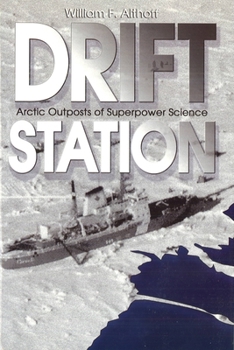Drift Station: Arctic Outposts of Superpower Science
Select Format
Select Condition 
Book Overview
Closed to conventional passage, the Arctic Ocean and peripheral seas have nevertheless known European explorers since the sixteenth century. Systematic observation, however, dates only from the last years of the nineteenth century, with the epic drift of Fridtjof Nansen's ice ship Fram (1893-1896), the first scientific expedition of the modern era. Twentieth-century technology--the icebreaker, radio transmission, nuclear power, and aircraft--opened...
Format:Hardcover
Language:English
ISBN:1574887718
ISBN13:9781574887716
Release Date:January 2007
Publisher:Potomac Books
Length:320 Pages
Weight:1.50 lbs.
Dimensions:1.3" x 6.4" x 8.9"
Customer Reviews
2 ratings
More than "Ice Station Zebra"
Published by Thriftbooks.com User , 15 years ago
"Drift Station: Arctic Outposts of Superpower Science" is a truly attention-grabbing narrative of efforts in the twentieth century to understand the northern polar region. It focuses on the story of Arctic science propelled by imperial ambitions to the present. Floating on the icecap, these stations operated by a multitude of nations have been both intentional and the unintended consequences of national scientific efforts. Althoff begins his narrative with a discussion of the science conducted during the three-year drift of the research vessel "Fram" between 1893 and 1896 while caught in the floe during an expedition led by Fridtjof Nansen. The Soviet Severnyy Polyus-1 (North Pole-1) or SP-1 expedition of 1937-1938 brought drift stations into the modern era and after an interruption for World War II they have been in continuous existence thereafter. The first American drift station was established in 1950 and other followed thereafter. Until the last one of finally shut down in 2004, the Soviet Union/Russia had created 32 such drift stations over the years. The Americans tended toward shorter term encampments but were always present in the Arctic as well. This time was extended by nuclear submarines beginning with the "Nautilus" in the 1950s, all which conducted certain types of experiments built on the needs of the U.S. military. In all cases, these scientific facilities were military in operation; and their place as key outposts collecting data on meteorology, oceanography, and other scientific disciplines held consequences beyond the geopolitical and national security interests that had sparked them in the first place. At the same time, Althoff makes clear that the strategic considerations of the North Pole for the Cold War transformed the region into a theater for military operations. This study offers a unique perspective on Arctic exploration. It is well worth reading.
A 'must' for any collection
Published by Thriftbooks.com User , 17 years ago
The Cold War and subsequent years saw governments staking claims in the Arctic through the establishment of isolated 'drift stations' on ice floes, which conducted key scientific research. While such stations were military in nature, they've evolved to become key outposts of scientific research, offering up studies in meteorology, oceanography, and other disciplines with results moving beyond the political and military interests of the superpowers and the Arctic nations. DRIFT STATION details history from early explorers to modern times and is a 'must' for any collection strong in either military or scientific history. Diane C. Donovan California Bookwatch





